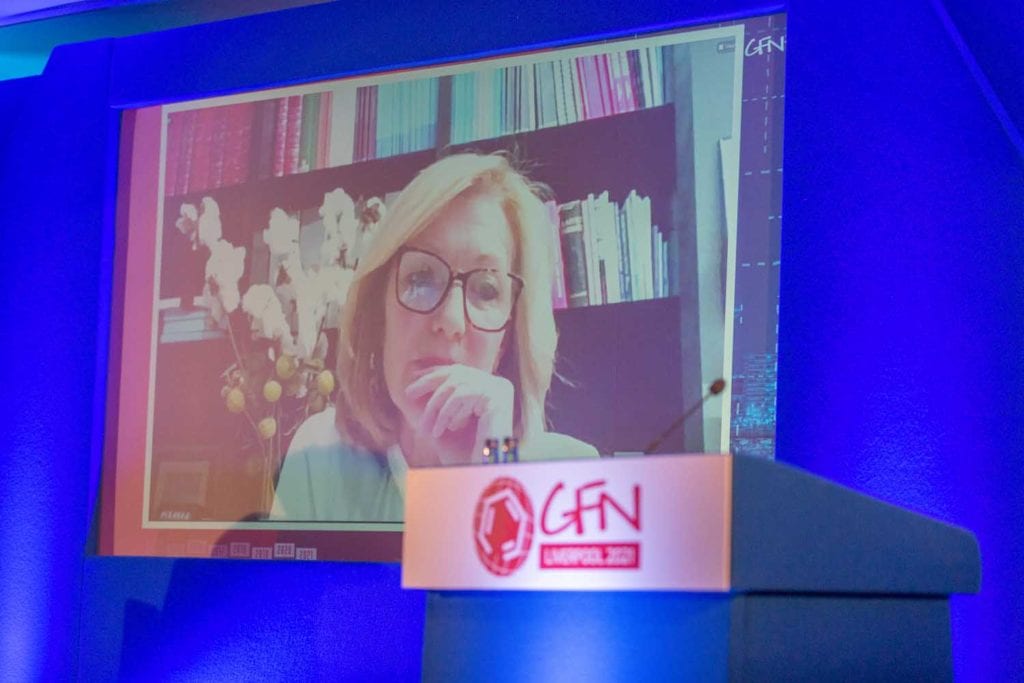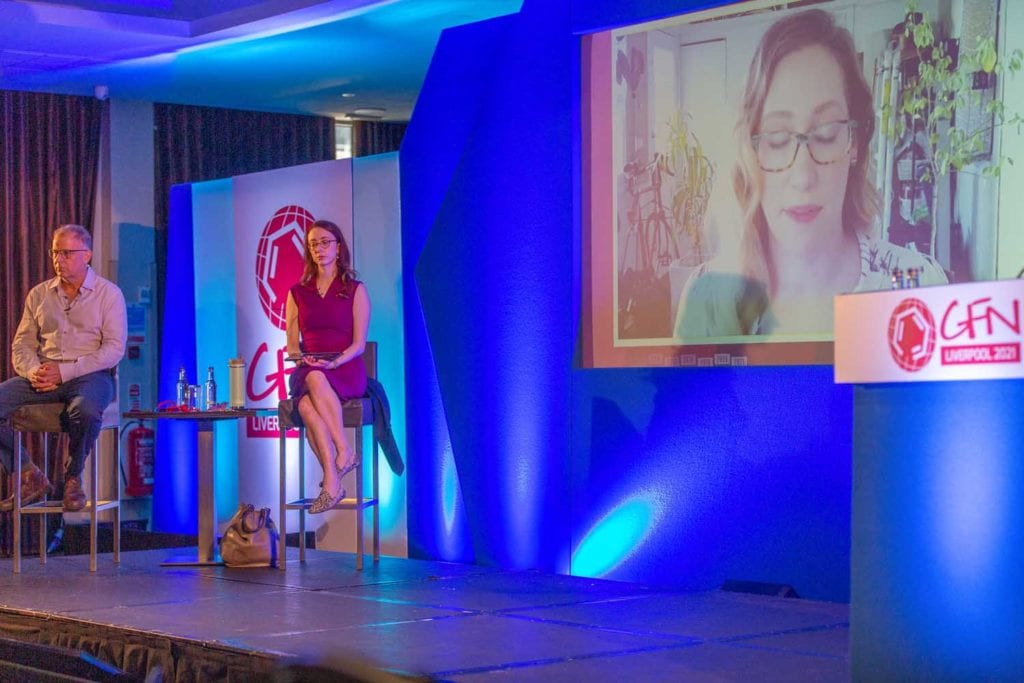The Way Forward
- Also in TR Events
- June 22, 2021
- 0
- 0
- 17 minutes read


The Global Forum on Nicotine debates harm reduction in Liverpool and online.
By George Gay
If you’ve ever been involved in organizing a conference, one of the issues you will have run into will almost certainly have concerned how long people are given to speak. Among the organizing committee, there will have been those who thought 40 minutes was a reasonable slot while others would have tended toward 10 minutes. I have always leaned to the view that 10 minutes is too long to listen to one person speaking, so I was delighted to find that this year, for the first time, the Global Forum on Nicotine (GFN) included a series of five-minute videos.
That’s the good news. The bad news, if you’re short of time, is that, at last count, there were about 75 of these videos, or GFN5s. That’s more than six hours in total. I have to confess to having watched only about half of them by the time I sat down to write this piece.
There is little lost and much to gain in keeping presentations short and watching them as videos. Unlike in the case of live presentations, at your convenience and depending on your mood, you can watch a video or not depending on your interest in the subject under discussion. You can pause it and go back if you need to check something. And, if your interest is such that you want further information, most of the video makers provide details of how to go about finding it or making contact. Importantly, you can yell at the screen.
The GFN5s formed part of the 8th Global Forum on Nicotine held June 17–18 at the Crowne Plaza Hotel in Liverpool, U.K., and virtually under the theme: “The future for nicotine.” The program comprised three keynote presentations: Science and Politics: An Often Fractious Relationship; Investments in Nicotine Innovation: Risks and Rewards for Public Health; and Why Has the WHO FCTC [Framework Convention on Tobacco Control] Failed to Reduce Adult Smoking and Its Health Impact? There were, in addition, four panel discussions: Science: Orthodoxy, Challenges and Dissent; Who Uses Nicotine and Why?; Obstacles to Tobacco Harm Reduction in LMICs [lower-income and middle-income countries]; and Safer Product Regulation: Supporting or Undermining the End of Smoking? The keynote and panel presentations were interspersed with the streaming of GFN5s and analyses by a commentary team, and toward the end of the event, there was a consumer voices panel.
This was the first hybrid GFN, but conferencing with at least an element of virtual interaction has got to be the way ahead. There is little point, it seems to me, in constructing long-term strategies for reducing the harm caused by smoking tobacco if it means hundreds of people flying around the world, adding to a climate emergency that will “kill” us all anyway. I don’t know whether it was intentional, but there was a neat reference to such matters in one of the pre-panel-discussion videos, which were longer than the GFN5s. As one of the panelists delivered her presentation about the FCTC and tobacco harm reduction, hanging on the wall in the background was a print of London’s former Battersea power station belching out what looked like smoke. Having grown up in London with nonsmoking parents, my health would have been negatively affected more by the Battersea smoke and the general pollution of what was then a highly polluted city than by tobacco smoke.

Expanded Reach
Virtual events clearly work. The effects of the Covid-19 pandemic meant that the GFN conference organizer, KAC Communications, was forced to move the 2020 conference online; but even though this had to be done at short notice, GFN20 reached a bigger audience than ever before. Two thousand people registered from more than 100 countries, a number that included many consumers from around the world who were able to join the event for the first time. Compare this with the 1,100 from 87 countries who registered for the 2021 event.
There is, of course, considerable pressure building up among those who find virtual events unsatisfying and those with an interest in flying people around the world and putting them up in hotels. And KAC recognized this point in a pre-2021-event press release that, in part, said more than a year of online meetings had “taken their toll.” But, the organizer, which has a history of introducing innovative ideas to its conferences, reacted to this situation by aiming “to reenergize the digital format.” “A new GFN TV online platform will stream broadcast-quality footage of the conference free to viewers around the world, with a new commentary team offering their insights,” the press note said. This format worked well, in my estimation.
Again, this must surely be the way ahead. It would be a tragic waste in my view if, after having been forced by the Covid-19 pandemic to look more closely at virtual or hybrid conferences, we abandoned them at the first opportunity. It will take time for people to adjust to the new virtuality, but they will do so, especially if the way is eased by using innovative techniques. How can THR advocates preach to tobacco smokers about the health benefits of moving to “virtual smoking” with electronic cigarettes if they are not willing for the sake of the climate—for the sake of everyone’s health—to move to virtual meetings?
One of the great advantages of the GFN5s is that, while they offer the opportunity for the old lags to have another say, they also allow those watching to see and hear from people who they would not normally come across giving presentations at conferences—to learn things they probably wouldn’t have learned otherwise. What better reason to “attend” a conference? Having said that, I should point out that the GFN has always been an inclusive event. I attended the first GFN and learned a lot from a group of attendees whose main—and considerable—claim to expertise was that they were vapers and vaper advocates.
Another advantage is that the videos, which aren’t all five minutes in length, cover a range of styles and levels of professionalism that help hold the attention—watch out for the duck in one of them—better than does the usual, largely unchanging backdrop of traditional conferences, which are often held in windowless hotel bunkers where natural light rarely penetrates—with, I would suggest, the inevitable consequences.

The Heart of the Matter
I would recommend that anybody interested in questions surrounding tobacco harm reduction take a look at these videos, but I shall draw attention to just two. I am not saying that these are the best of the bunch; I have, after all, listened to and watched fewer than half of them. But these two videos contained significant messages in my view. One, by John Oyston, a retired anesthesiologist, sought to answer the question of why many people working in the medical profession have not fully embraced the idea of tobacco harm reduction using electronic cigarettes, and made suggestions about how they might be brought on board in the future. It wasn’t that Oyston said anything new, but he brought to his presentation the insights and authority of a retired medical professional who had boiled down the salient points into a five-minute talk that, unlike some of the more data-filled presentations, got to the heart of the matter in a way that could be understood and appreciated by anybody. It deserves a wide audience.
There was something a little disturbing about Oyston’s presentation, however. This was the eighth annual GFN, and we are still apparently in a position where we are casting about for ways to get medical professionals on board. Indeed, we are still trying to get many health professionals to understand that nicotine doesn’t cause cancer. And we still seem to be in the situation where we leave each annual conference with the same words ringing in our ears—we need to refute the bad science being put about so that the messaging changes and a large majority of people accept the idea that nicotine is not the problem and can be delivered in ways that are far safer than is the case with tobacco smoking. In fact, one of the messages that came across a number of times was that science was losing out to politics and ideology, with the result that nicotine was being shoehorned into the evil empire where tobacco dwells.
This has to raise the question: do we need a plan B? Given that the object of the exercise is to encourage smokers to quit their habit, not necessarily the promotion of alternative nicotine-delivery systems, do we need to look at things again? At what point do we have to accept that, however wrong they might be, the people at the WHO and others opposed to THR have won?
One of the disheartening aspects of the conference was to see on one of the panels an unusually subdued Konstantinos Farsalinos, a physician and senior researcher at the University of Patras and the University of West Attica’s National School of Public Health in Greece. Farsalinos’ work in demonstrating the validity or otherwise of THR science has been invaluable for the nonscientists among us. But in a recent piece on Qeios, he explains how a report by journalists in the BMJ had confused his work on an aspect of Covid-19 with unconnected THR research, and had wrongly accused him of the nondeclaration of interests. But worst of all for Farsalinos, I think, was the fact that he was not allowed a right of reply in the same journal.
The next question that inevitably pops up, I guess, is outside the scope of the likes of GFN conferences. It concerns how it might be possible to encourage smokers to quit their habit without the use of nicotine alternatives. And here I mean “encourage.” What passes for “encouragement” among much of the tobacco control community is, to my way of thinking, “bullying.” It is largely about raising taxes to levels that render poorer the already financially impoverished. And in this respect, I was gladdened to hear one panelist point out that piling taxes and stigma on smokers is not ethical; indeed, it is reprehensible.
And there was some encouragement here from my other choice of videos. This one, narrated by Kevin McGirr, concerned an observational study targeting tobacco-using individuals with substance use or mental health disorders—people who make up a disproportionate amount of smoking populations. What I particularly liked about this study was its humanity—the way it has been constructed to allow the researchers to work with smokers, not work on them. Participants, who have to have shown some interest in altering their smoking habits, might not have abstinence as their final goal, which they set themselves. The researchers do not even use the term cessation.

A Breath of Fresh Air
Meanwhile, the conference allowed participants also to access in advance of the panel discussions videos made by some of the panelists. Again, these were worth watching, but I will draw attention to just two, which addressed, in part, an issue that many people within THR find almost incomprehensible—at least in a rational world. Why, when apparently most people are desperate to reduce toward zero the health problems caused by tobacco smoking and after more than 10 years of the cause of THR being supported by less risky products that some smokers find can substitute for cigarettes, has the idea of THR not gained more traction? Brad Rodu clearly demonstrated in his presentation how part of the reason in the U.S. is down to the way that most scientific research funding is made. In the other presentation, Michelle Minton explained how government policies in the U.S. are driven by the fears and wishes of the majority population, made up of the suburban, white middle classes. This is why tobacco smoking, a habit mainly of the financially less well-off, has been largely tolerated, while vaping, the subject of scare stories about an epidemic among the children of the middle class, has launched a moral panic.
Interestingly, given that THR has failed to gain the traction that logic suggests it should have, we were told during the conference that the FCTC was fit for purpose. I should point out that this statement was made in respect of the treaty’s text and the way it provided for parties to the treaty to embrace THR. It was not a comment about whether or how effectively THR principles had been applied. But given what has happened, it does raise a question about what is this “purpose” that it is fit for? After all, the nations of the world didn’t have to rely on the establishment of the treaty to embrace THR. It has always been my view that creating an international treaty around a legal consumer product was simply an extravagant and bizarre exercise in bureaucracy whose purpose was the creation of an endless series of environment-destroying conferences. Indeed, this sense of endlessness was suggested in a comment by one of the people associated with the FCTC when he prefaced a comment with: “If we are to finally end the use of combustible cigarettes …” There is a sense that we are content to drift from conference to conference, chewing over the same ideas and getting almost nowhere: in fact, in many places stagnating or even going backward.
So it was good that the Australian MP, Fiona Patten, a Member for the Northern Metropolitan Region in the Victorian Parliament’s Legislative Council and leader of the Reason Party, who gave the first—remote—keynote presentation, brought a breath of fresh air into the proceedings. Patten was clearly frustrated at the irrationality of Australia’s politicians who for a long time ignored the science about the dangers of tobacco smoking and today are arguing that there is not enough science to sanction alternative nicotine products. She was funny and feisty and clearly determined to get her way in respect of THR. And perhaps she will. As she, and others at the GFN pointed out, if the Covid-19 pandemic has delivered one positive, it is that politicians have been forced to listen to scientists.
Being a man and not a scientist, I wasn’t able to follow the complex reasoning through which Patten compared the clitoris with vaping devices, but the images conjured up did remind me briefly of a till-then long-forgotten Billy Connelly story about changing batteries in small electrical devices. And I would like to conclude by saying that it is surely time to give much more attention at THR conferences to considering the relative environmental impacts of tobacco and nicotine products. If we did end up converting 1.1 billion smokers worldwide to vaping, that would be an awful lot of batteries.
The organizer will be making GFN presentations available as individual sessions shortly, but for the time being, Day 1 presentations are available here.
The GFN is due to return to its live format and its “home” in Warsaw, Poland, next year on June 16–18.


